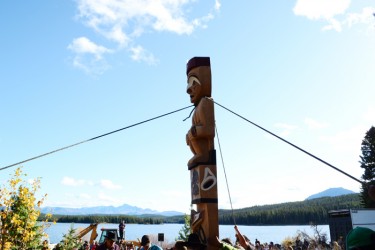Article Origin
Volume
Issue
Year
A decision by the Supreme Court of Canada earlier this year that recognized Tsilhqot’in title has led to the designation of more than 300,000 hectares as a tribal park. The Dasiqox Tribal Park will be controlled by the Xeni Gwet’in and Yunesit’in Government.
“The significance of this (designation) is coming out of the title case in June this year,” said Chief Russell Myers Ross of the Yunesit’in Government. “It’s trying to get us a proper footing to engage the province in how we see the title case evolving…. The core of what the title case said is that Aboriginal perspectives need to be included, our values and our laws.”
On Oct.4, in a totem pole raising ceremony at Teztan Biny, the Tsilhqot’in Nation announced its intention to create Dasiqox Tribal Park, the boundaries of which would connect the broader landscape to link surrounding protected areas, including Ts’il?os, Nunsti, Big Creek, Eleven Sisters and the South Chilcotin Mountains Provincial Parks.
The tribal park designation would not preclude economic development.
“Probably our biggest challenge, probably where our energy is going to be focused on the most, is trying to determine how we manage the area so that we’re able to at least have ecological and biological standards for the area but also be trying to develop and market and put more value into the land,” said Myers Ross.
The Tsilhqot’in National Government will be developing a position paper outlining Dasiqox Tribal Park, including “reflecting on key values” such as economics, biology, and culture. Feedback, which will focus more on “people’s aspirations and yearnings,” will be solicited primarily from local residents but also stakeholders, including businesses and local governments.
“I think the focus there is the aspect of sustainability because we know as First Nations we’re going to be there forever and we want there to be an economy that is renewable and that we can continue to participate in….We need the aspect of sustainability, for the land to be there forever, economically,” said Myers Ross.
Myers Ross also notes that the province has an important role to play.
“Part of the reason why we didn’t want to get to the point where we implement (the park) is because we wanted to invite the province to be part of the process,” he said. “What we want to do, the Tsilhqot’in Nation, is the two communities, we want to try to find a different way to resolve conflicts around land and resource development. So this is one of the ways.”
Myers Ross points to the conflicts that have existed in the past when it comes to logging and mining on First Nations traditional territory, including a recent unsuccessful bid by Taseko Mines Ltd. to continue exploration work in the region now to be designated a tribal park.
“Our biggest emphasis with the province will be trying to develop an accord, probably a land use plan,” he said. “How much we both put our efforts and energy into it, I’m not sure yet.”
In a report produced for the Xeni Gwet’in and Yunesit’in First Nations on the area, wildlife biologist Wayne McCrory noted that the 2013 report by MP Paquet to the Friends of Nemaiah Valley, stated, “‘Tribal park’ is not a legally recognised designation, either provincially or federally. The BC government has considered them to be Crown lands and will allow logging, mining, and other industrial uses of, and activities on, these lands.”
While that may be the case, Myers Ross says he knows that at least local governments have “recognized aspects of tribal parks.”
And there has been precedent set. In 1984, the Tla-o-qui-aht established four tribal parks in Clayoquot Sound and stopped logging. Those tribal parks continue to exist three decades later.
In his report, McCrory stated, “Given the imminence of proposed logging plans and
mining interests, declaration as a Tribal Park (Dasiqox) should be considered as quickly as possible.”
The push to designate Dasiqox Tribal Park became “more intense” in February, said Myers Ross, although the concept has been discussed for a number of years.
- 2076 views

